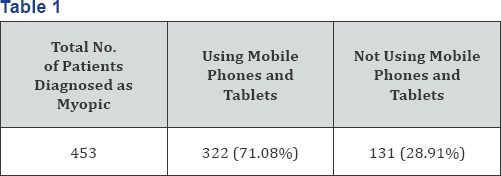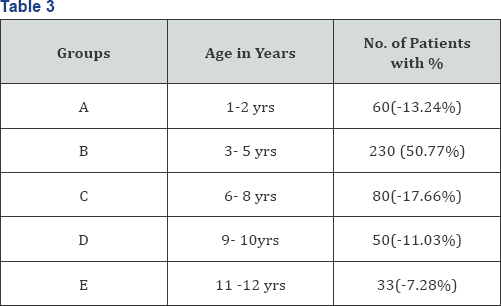JUNIPER
PUBLISHERS- JOJ Ophthalmology
Incidence of Myopia in Relation to Close work at Indus Medical College Hospital, Tando Mohammad Khan
Purpose: To evaluate the incidence of myopia
in relation with close near work particularly in those children involved
in using small screen tablets and mobiles phones.
Material and methods: This study was conducted
between January 2016 to June 2016 to know the incidence of myopic
refractive error in children between 1 to 12 years in outpatient
department of Indus medical college hospital and particularly the effect
of close work like using tablets and mobile phones upon these children
.We included 453 children who were diagnosed as myopic and having
astigmatism , most of the children 322(71.08%) were using tablets and
mobile while 131 (28.91%) were not involve in using mobile and tablets.
197 (43.48%) were boys while remaining 256(56.51%) were girls . They
were divided into different age groups i.e. 60 (13.24%) children, were
in age group A, majority of children 230(50.77%) belonged to group B, 80
(17.66%) were in age group C, 50 (11.03%) in group D and 33(7.28%) were
in age group E. All of the patients in groups A to C and those non
co-operative from group D and E were under gone cycloplegic refraction.
Results: Out of 453 children 203(44.81%) found
to have myopia of up to -3.0D, 87(19.20%) have myopia of up to -2.0D,
67(14.79%) have myopia of up to -4.0D and 96(21.19%) having myopia of
-1.0D. majority of patients i.e. 301(66.44%) having astigmatism of up to
-1D, 83(18.32%) have astigmatism of up to -2.0D, 52(11.47%) were having
astigmatism of up to - 3.0D and 17(3.75%) having astigmatism of up to
-4.0D. Majority of patients (though female ratio higher than male ratio)
were having myopic astigmatism of up to -1.0D , in the age group B i.e.
between ages of 3 to 5 years and were involved in using mobiles and
tablets.
Conclusion: Myopia is the more prevalent
refractive error all over the world .in our study it is more prevalent
in children between the ages 2 to 5 years of age particularly involved
in close near work like apart from studying they were using mobiles and
tablets particularly small screen for longer time. So better to use
large screen avoid reading in dim light, do not use these small screens
in lying position. Parents must take care while allowing the children to
use mobiles and tablets screens must not be less than 12 inches in size
better to allow them computers (desk top) rather than these small
screens.
Keywords: Khan NA; Khan AA;
Memon JI; Incidence of myopia in relation to close work at indus
medical college hospital; Tando- Mohammad KhanIntroduction
Uncorrected refractive errors are a common cause of preventable blindness worldwide [1] and myopia is the result of complex hereditary and environmental factors, [2] most prevalent refractive error [3]
defined as near sightedness caused by an incongruity between the power
of the optical elements of the eye and its axial length. The object
image is projected in front of the retina, and corrective lenses are
necessary to displace the image backward, thus producing a clear retinal
image. Although the causes of myopia are unclear, evidence supports
both genetic and environmental components, among which are higher
amounts of near work [4,5] years of education [6] and intelligence[7].
The world-wide urban rural patterns derived from both incidence and
prevalence data are consistent with the near work hypothesis that
increased reading and computer use may be a risk factor for myopia [5].
Researchers point to rigorous schooling system and the long hours
children spend studying as being responsible for the high rates of
myopia in Asia, rates that may be on the increase [8,9]. As myopia has onset and progression in childhood, it is important to focus research on these age groups.
Material and Methods
This study was conducted between January 2016 to June
2016 at Indus Medical College Hospital to know the incidence of myopic
refractive error in children between 1 to 12 years and particularly to
know the effect of using tablets and mobile phones upon these children.
We included 453 children who were diagnosed as myopic and having
astigmatism , most of the children 322 (71.08%) were using tablets and
mobile while 131 (28.91%) were not involve in using mobile and tablets, (Table1). 197 (43.48%) were boys while remaining 256 (56.51%) were girls, (Table 2).
They were divided into different age groups i.e. 60 (13.24%) children
were in age group A, majority of children 230 (50.77%) belonged to group
B, 80 (17.66%) were in age group C, 50 (11.03%) in group D and 33
(7.28%) were in age group E, (Table 3). All of the patients in groups A to C and those non co-operative from group D and E were under gone cycloplegic refraction.



Results
Out of 453 children 203 (44.81%) found to have myopia
of up to -3.0D, 87 (19.20%) have myopia of up to -2.0D, 67 (14.79%)
have myopia of up to -4.0D and 96 (21.19%) having myopia of -1.0D (Table 4).
Majority of patients i.e. 301 (66.44%) having astigmatism of up to -1D,
83 (18.32%) have astigmatism of up to -2.0D, 52 (11.47%) were having
astigmatism of up to -3.0D and 17 (3.75%) having astigmatism of up to
-4.0D (Table 5).


Majority of patients (though female ratio higher than
male ratio) were having myopic astigmatism of up to -3.0D, in the age
group B i. e. between ages of 3 to 5 years and were involved in using
mobile phones and tablets.
Discussion
In our study we included only patients between ages 1
to 12 years, were involved in close near work for long time
particularly spending more time on mobile phones and tablets apart from
their study time. We found that out of 453 myopic patients the highest
rate of myopia, 44.81% was in the age group B (3-5yrs) and particularly
these children were involved in using mobile phone and tablets for
longer time, in a study done in 2011 at Dow University Hospital Karachi
Pakistan by Rasheed et al. [10]
shows rate of myopia was 26.6% while a multicenter study done in China,
Chile and Nepal that shows the prevalence rates of myopia were16.2%,
5.8% and 0.3% in China.
Chile and Nepal respectively it is less than our
study in another study the rate was almost same as our study that was
conducted in Singapore and china, the prevalence rate of myopia in
Singapore children was 36.7% compared to Xiamen (China) which was 18.5%.
Singapore has highly competitive educational system, whereas Xiamen
school system is not so demanding, more near work activity may explain
the difference in the prevalence rates [11,12].
An epidemiological study, concerning the prevalence of myopia among the
student population (15-18 years old) though the age is high as compare
to our study of Northern Greece, myopia prevalence was 36.8% same as our
results, It was found that myopia correlates strongly with near work
and school performance [13].
Boys in orthodox Jewish schools were found to have higher rates of
myopia (81.3%) that is too high ratio as compared to our study while
boys in general Jewish schools have only (27.4%) myopia. Orthodox
schooling is characterized by sustained near vision139and frequent
change in accommodation due to the swaying habit during study [14].
In Xiamen, China the prevalence of myopia in urban school children was
19.3% and in rural school children was 6.6%. The average hours per day
children spent in reading and writing outside of school was 2.2 hours in
the city compared with 1.6 hours in is higher in the city than in the
country side.These data suggest the prevalence of myopia is higher in
the city than in the country side. One possible explanation for these
different rates could be that school children in the city spend more
time reading and writing outside of school compared with children in the
countryside. Myopic children in both the city and the countryside spent
more time reading and writing compared with non myopic children. This
increased near-work activity may contribute to the prevalence of myopia [15].
So the above studies prove same as ours that the time spent for close
near work is directly related to the increase in prevalence of myopia
with only change that children of this era are using mobile phones and
tablets rather than only studying.
Conclusion
Myopia is the more prevalent refractive error all
over the world in our study it is more prevalent in children between the
ages 2 to 5 years of age particularly involved in close near work like,
apart from studying they were using mobiles and tablets particularly
small screen for longer time. So better to use large screen avoid
reading in dim light, do not use these small screens in lying position.
Parents must take care while allowing the children to use mobiles and
tablets, screens must not be less than 12 inches in size better to allow
them computers (desk top) rather than these small screens.
For more articles in JOJ Ophthalmology (JOJO) please click on: https://juniperpublishers.com/jojo/index.php
No comments:
Post a Comment